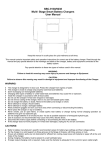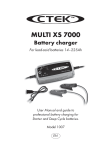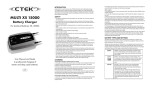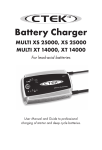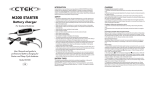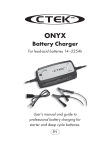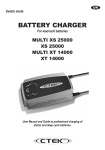Download CTEK MULTI XT 4000 User manual
Transcript
MULTI XT 4000 Battery charger For lead-acid batteries 8–100Ah User Manual and guide to professional battery charging for Starter and Deep Cycle batteries. Model 1008 EN INTRODUCTION Congratulations on your purchase of your new professional MULTI XT 4000 Switch Mode Charger with Pulse Maintenance, Float, Analysis and Recond. MULTI XT 4000 is a member of a family of professional chargers from CTEK Sweden AB. It represents the state-of-the-art technology for battery charging. A MULTI XT 4000 will prolong the lifetime of your battery. Read this user manual and follow the instructions carefully before using the charger. SAFETY • The charger is designed for lead-acid batteries from 8–100Ah. However, the charger can maintain batteries up to 250Ah. Do not use the charger for any other purpose • Use safety glasses and turn your head away when connecting or disconnecting a battery. • Battery acid is corrosive. Rinse immediately with water if acid comes into contact with skin or eyes. Seek medical advice. • Make sure that the cable is not being pinched or in contact with warm surfaces or sharp edges. • While charging, a battery can emit explosive gases, so it is important to avoid sparks in the immediate area. • Always provide for proper ventilation during charging. • Avoid covering the charger. • Make sure that the electrical cable does not come into contact with water. • Never charge a frozen battery. • Never charge a damaged battery. • Do not place the charger on the battery while charging. • The electrical connection must fulfil the national heavy current requirements. • Check the cabling before use. Make sure there are no cracks in the cabling or in the protective covering. A charger with damaged cables may not be used. • Always check that the charger has gone over to maintenance charging mode before leaving the charger unattended and connected for long periods. If the charger had not gone over to maintenance charging within 3 days, this is an indication of a problem. In this case the charger must be disconnected manually. • All batteries fail sooner or later. A battery that fails during charging is normally taken care of by the chargers advanced control, but certain uncommon errors in the battery can still arise. Don’t leave the battery charger unattended for a longer period of time. • Only mount the charger on a flat surface. • This equipment may not be used by children or by those who can not read and understand the manual if they are not supervised by a responsible person who can guarantee that the battery charger is being used in a safe manner. Store and use the battery charger out of the reach of children. Make sure that children do not play with the battery charger. BATTERY TYPES AND SETTINGS MULTI XT 4000 can easily be configured to charge many different types of 24V lead-acid batteries; wet batteries, MF, AGM and for most GEL-batteries. The following recommendations should, however, only be seen as guidelines. When in doubt, always consult the battery manufacturer for further instructions. Settings are made by pressing the “MODE-button” and stepping forward by pressing the button one step at a time, releasing the button when the required mode is reached. After approx. 2 seconds, the charger activates the chosen mode. The selected mode is saved in the charger’s memory and remains even when the charger is switched off. Mode ”NORMAL” (28.8V) Normal setting for wet batteries, MF and for most Gel batteries. Mode ”SNOWFLAKE” (29.4V) This setting is recommended for batteries at temperatures below 5°C. It is also recommended for many AGM batteries. This setting is not recommended for maintenance charging when the temperature at times exceeds +5°C. In this case, the NORMAL mode is recommended. Mode ”RECOND” (31.4V, 0.9A 0.5–4h) This mode is used to recondition very discharged batteries where you could expect a stratified acid (high acid weight in the bottom, low on top). Use this mode with care because it can cause some water loss. 31.4V is normally not a problem for electronics, but consult the manufacturer when in doubt. Life of light bulbs can be reduced by higher voltages. Try to avoid using 24V lamps connected to the battery during this phase. Maximum effect and minimum risk for electronics is achieved by disconnecting the battery before charging. CHARGING Charging batteries mounted in a vehicle: 1. The power cord should be disconnected before connecting or disconnecting the battery leads. 2. Identify the pole that is grounded (attached to the chassis). Ground is normally connected to the negative terminal. 3. Charging a negatively grounded battery. Connect the red wire to the positive pole of the battery and the black cable to the vehicle’s chassis. Be careful not to connect the black cable in the vicinity of a fuel pipe or the battery. 4. Charging a positively grounded battery. Connect the black wire to the negative pole of the battery and the red cable to the vehicle's chassis. Be careful not to connect the red cable in the vicinity of a fuel pipe or the battery. Charging of a battery not connected to a vehicle: 1. The power cord should be disconnected before connecting or disconnecting the battery leads. 2. Connect the red wire to the positive pole of the battery and the black cable to the negative pole. Connecting the provided cables with eyelet terminals: Make sure that the cable is not being pinched or in contact with warm surfaces or sharp edges. When the cable is mounted on the battery, it should not be connected to the charger. Connect the eyelet terminals to the battery's poles - the red cable to the positive pole and the black cable to the negative pole. After this, the quick connector can be connected. Reverse Polarity Protection If the battery cables are connected incorrectly, the reverse polarity protection will make sure that the charger and the battery are not damaged. In this case, the red warning lamp (0) will be lit. Start charging 1. Connect the power cord to the power outlet. 2. Set the proper charging mode for the battery by pushing the Mode button until the correct setting is lit. Choosing settings for your battery is described under ”BATTERY TYPES AND SETTINGS”. 3. The lamp for Deep Discharged battery (1) will indicate if the battery voltage is low. If lamp 1 blinks, this indicates that the battery is lightly sulphated. Read more under ”CHARGING PHASES” 4. Normal charging is indicated by the following lamps: Deep Discharged (1), Bulk Charge (2), Absorption Charge (3) or Maintenance Charging (4). When the maintenance lamp is lit, the battery is fully charged. The charge will restart if the voltage drops. The charger can be connected for months. RECOND is indicated when the lamp for these setting is lit (5). 5. If the battery cables are connected incorrectly, the reverse polarity protection will make sure that neither the charger nor the battery are damaged. In this case, the red warning lamp (0) will be lit. 6. If nothing happens. If the setting lamp is lit but no other light goes on, the connection to the battery or to the chassis may be bad, or the battery may be bad. Start by improving the contact between the battery and the charger. 7. Charging can be interrupted at any time by disconnecting the power from the wall socket or by putting the charger in "Standby" mode (lamp A). Always disconnect the power cable from the wall socket before removing the battery cables. When you interrupt charging of a battery mounted in a vehicle, always disconnect the battery cable from the chassis before removing the other battery cable. IMPORTANT INFORMATION Please note that the battery pack in the 24V system in most cases consists of more than one battery. They are linked up to the 24V system, but the individual batteries generally have a lower voltage. Therefore it is important for the charger to be connected correctly. CHARGING PHASES Mode chosen: ”NORMAL” or ”SNOWFLAKE” MULTI XT 4000 is a multi stage fully automatic charger. Lamp B for chosen setting ”NORMAL” and lamp C for chosen setting ”SNOWFLAKE”. Desulphation (Lamp 1, blinking) Desulphation with pulsing for sulphated batteries. Indicated by blinking lamp 1. Start (Lamp 1) Starting phase for charging. The starting phase continues until the battery’s terminal voltage has risen over a preset level. At this point, charging goes into the bulk phase. If the terminal voltage has not reached the preset level within 8 hours, charging is suspended. The error mode is indicated. This indicates a battery which is faulty or has too large capacity. If a large battery is charged that has been severely discharged, it may be necessary to restart the charger after 8 hours. Start is indicated by lamp 1. Bulk (Lamp 2) Primary charging where approximately 80% of the charging takes place. The charger delivers maximum voltage until the terminal voltage has risen to the preset level. After a number of hours, the charger goes on to the next phase, even if maximum voltage is not reached. Bulk is indicated by lamp 2. Absorption (Lamp 3) Final charging, voltage is kept at the preset level. During this phase, the voltage is gradually reduced. If the maximum length of time for Absorption is exceeded, the charger automatically continues with Analysis. Absorption is indicated by lamp 3. Analysis (Lamp 3) Charging is suspended for a short period and the battery voltage measured. If it falls too quickly, the battery is probably faulty. Charging is suspended and an error is indicated (lamp 0). Maintenance charging - float (Lamp 4) During the first 10 days of maintenance charging the battery is maintained with constant voltage, 27.2V. Float-maintenance is indicated by lamp 4. Maintenance charging - pulse (Lamp 4) State of charge varies between 95% and 100%. The battery receives a pulse when the voltage sinks, keeping the battery in good shape when it is not being used. The charger can be connected for months at a time. If the battery is charged and/or the battery’s terminal voltage drops, the charger starts a charge pulse until the voltage has reached the preset level, 28.8V or 29.4V. The charge pulse is then interrupted and the cycle is repeated as long as the charger is in pulse maintenance phase. If the terminal voltage drops even lower, the charger automatically reverts to the beginning of the charging curve. Pulse maintenance phase is indicated by lamp 4. If possible, check the water level in the battery. If an external load is connected, the charger will return to the Maintenance charge – float step. Chosen mode: ”RECOND” MULTI XT 4000 has a Recond mode which is used to recondition a battery that has been severely discharged. The battery is first charged using the mode ”NORMAL”. When the analysis phase is complete, the charger begins reconditioning the battery by providing a constant current of 0.9A and a maximum voltage of 31.4V. After 0.5–4 hours, the battery is completely reconditioned and the charger goes into pulse maintenance. The battery is ready to be used, or store it with pulse maintenance active until you are ready to use the battery. Recond is indicated by lamp D and lamp 5. Note that the recond phase begins with a normal charging and that the charger therefore will indicate the charging phases according to the descriptions above first. Lamp 5 is first lit when the reconditioning begins. TEMPERATURE PROTECTION MULTI XT 4000 is protected from being overheated. The power will be reduced if the ambient temperature is raised. MAINTENANCE The charger is maintenance free. Note that disassembly of the charger is not permitted and will void the warranty. If the power cord is damaged, the charger must be left to the reseller for maintenance. The case can be cleaned with a soft damp cloth and mild cleanser. The charger should be disconnected from the power while cleaning. EQUIPMENT MULTI XT 4000 is delivered with a set of battery leads with battery pole clamps and a set of battery leads with eyelet terminals. WARRANTY CTEK SWEDEN AB, Rostugnsvägen 3, SE-776 70 VIKMANSHYTTAN, SWEDEN provides a limited warranty to the original purchaser of this product. This limited warranty is not transferable. The unit is warranted against defective workmanship or materials for 2 years from the date of purchase. The customer must return the product together with the original purchase receipt to the place of purchase. This warranty is void if the unit is handled carelessly, opened or repaired by anyone other than CTEK SWEDEN AB or its authorized representative. CTEK SWEDEN AB makes no warranty other than this limited warranty and expressly excludes any implied warranty including any warranty for consequential damages. This is the only expressed limited warranty and CTEK SWEDEN AB neither assumes nor authorizes anyone to assume or make any other obligation towards the product other than his limited warranty. TECHNICAL SPECIFICATION Model Voltage AC Back current drain* Voltage Ripple** Current Ambient Temperature Cooling Charging cycle Type of batteries Battery Capacity Dimensions Insulation Weight 1008 170–260VAC, 50–60Hz < 1mA Charging Voltage Nominal: 24V 28.8V; 29.4V or 31.4V Max 5% rms 4A max -20°C to +50°C, power is reduced automatically at increased ambient temperature. Natural convection. MULTI XT 4000 is a multi stage fully automatic charger All types of 24V lead-acid batteries (Wet, MF, AGM and GEL). 8–100Ah 191 x 89 x 48 mm (L x W x H) IP65*** 0.8kg *) Back Current Drain is what the charger uses to drain the battery if the power cord is disconnected. **) Quality of the current and voltage are very important. High current ripple heats up the battery and makes the positive electrode age prematurely. High voltage ripple could harm other equipment connected to the battery. MULTI XT 4000 produces a high quality current and voltage with very low ripple. ***) If the power connected is the flat European contact type, the battery charger has insulation class IP63, except in Switzerland where IP65 is valid. MANUFACTURER’S DECLARATION CTEK SWEDEN AB, Rostugnsvägen 3, SE-776 70 VIKMANSHYTTAN, SWEDEN. Declares under sole responsibility that the battery charger MULTI XT 4000, to which this declaration relates is in conformity with the following LVD standards: EN60335-1, EN60335-2-29 according to the terms of directive 73/23/EEC with the addition of 93/68/EEC. This product also is in agreement with the following EMC standards: EN61000-3-3, EN61000-3-2, EN55014-1 and EN55014-2 according to the terms of directive 89/336/EEC with the addition of 92/31/EEC and 93/68/EEC. The charger comes in different models with different types of electrical plugs. The charger with WKHÀDWHXURFRQQHFWRULVLQWHQGHGIRU6ZLW]HUODQG VIKMANSHYTTAN, SWEDEN 2006-01-23 Börje Maleus, Managing Director CTEK SWEDEN AB, Rostugnsvägen 3 SE-776 70 VIKMANSHYTTAN, SWEDEN Fax: +46 225 30793 www.ctek.com INDICATIONS 3 2 0 4 1 5 RECOND A B C D RECOND Indication Description 0 Error mode, the charger suspends the charging / voltage maintenance. See further description below. 1 Start mode. 2 Bulk charging, maximum voltage. 3 Absorption charging, voltage limited to chosen voltage. 4 Pulse maintenance charging 5 Recond charging Indication A B C D Description STANDBY Mode ”NORMAL” (28.8V) Mode ”SNOWFLAKE” (29.4V) Mode ”RECOND” (31.4V, 0.9A 0.5–4h) Error mode The charger enters error mode before start in the following situations: • The battery is connected with poles reversed to the charger’s terminals. • The terminals on the charger are short-circuited. Error mode before start is reset by removing the error situation. The charger restarts in the latest selected mode. The charger enters steady error mode in the following situations: • The charger’s analysis function has interrupted charging. • The charger has been in start mode longer than maximum time. Steady error mode is acknowledged/reset by pressing the ”MODE” button. The charger restarts in the latest selected mode. CHARGING TIME The table shows the length of time for bulk charging. Battery size (Ah) Time to ~80% charge (h) 8 2 20 5 60 14 100 20 20010778E









